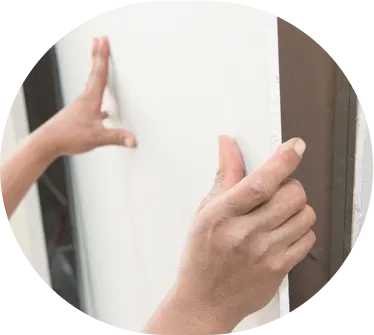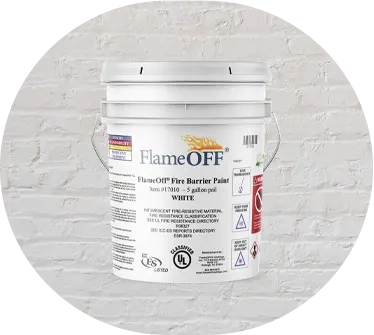Achieve a 2 hour fire rating over 5/8" Type X Drywall using Intumescent Paint

As the construction, architecture, and contracting fields develop, the importance of following fire safety protocol in the design of buildings grows increasingly more strict. According to the US Fire Administration (USFA), over 1,300,000 fires were reported throughout America in 2018. Further, these fires were then responsible for approximately 3,600 deaths, many more injuries, and about $25.6 billion worth of damages.
These eye-opening statistics argue in favor of following strict adherence to the fire codes and restrictions set in place by safety organizations to ensure that proper precautions are taken when creating residential, commercial, industrial, and other types of buildings throughout communities. However, the type of fire rating a building must meet often depends on varying factors including building dimensions, the intended use of the building, the types of substrates employed in the construction of a building, along with some other criteria related to fire-safety such as sprinkler systems and proximity to other buildings.
For the purposes of this article, we will be focusing on the proper way to achieve a 2-hour fire rating for gypsum, the primary component of drywall. There will also be a focus on ⅝ Type X Drywall, otherwise known in the industry as Type X Drywall, which is particularly prevalent when it comes to fireproofing buildings.
What is Gypsum Used for?
Drywall is one of the most commonly used materials in construction around the world. The components of drywall are predominately a combination of gypsum, paper, and other additives that vary by manufacturer and intended purpose. Gypsum has many uses in modern construction and is commonly employed in the development of all types of buildings and other architectural projects, including the construction of roads and bridges.
The material gypsum is quite commonly found in nature, a mineral composed of calcium sulfate dihydrate. Gypsum has soft physical properties and can be found as the primary element of such tools like chalk, plaster, drywall, and even some sculpted artwork.
On its own, gypsum is not combustible, making it a popular choice as a construction material and for its applications in fire safety and ensuring proper fire ratings in buildings. In the construction context, gypsum is the main component of gypsum board, which is used to line ceilings, walls, roofs, and floors in many buildings. Alternative names for gypsum board include:
- Gyp board
- Plasterboard
- Wallboard
- Drywall
- Sheetrock
Besides the fact that one of the main components of this material is non-combustible, there are many other reasons why it has become the more popular choice of substrate in construction. In general gypsum board is not as expensive as other options such as fiberglass. Further, the material is easy to manage and has a diverse range of applications within the construction field.
As gypsum board is an incredibly popular choice in the design of modern buildings, it grows increasingly important that the proper fire rating is achieved for this substrate. Despite gypsum board being naturally resistant to fire, no known construction material is 100% fire-resistant.
There is some variation that comes with different drywall types, which are primarily based on differences in the dimensions that drywall panels are manufactured in. These variations are seen in differences in thickness, panel length, panel width, as well as the components used to create the boards. There are also a number of differences in drywall properties that ultimately dictate their intended function. For example, some specific drywalls are recommended for fire protection, while others are used for water resistance.
Listed below are the most common types of drywall and their associated uses.
- 1/4" thick panel drywall is less common than other types of drywall, but its use is typically employed to cover slightly curved surfaces or pre-existing drywall.
- 3/8" thick panel drywall is one of the more commonly sized types of drywall. It has a similar application to 1/4" drywall and is mostly used for repair purposes.
- 1/2" thick panel drywall is the standard dimension for interior residential designed buildings.
- 5/8" thick panel drywall, also known as Type X drywall is the thickest type of drywall and is typically used for ceilings because they don't sag as much as thinner drywall types may be prone to for this type of application. Also, this thickness may be used for buildings that demand greater fire resistance. In general, thicker drywall tends to be associated with higher fire resistance. However, the notion that the thicker a dry wall is the greater its fire resistance is not entirely correct.
- Type C is another drywall that is typically ⅝” thick, however it is known for having even greater fire resistance than type X drywall. The consistency of Type C drywall (containing fiberglass and other ingredients) allows it to expand more when exposed to heat creating even greater fire resistance than provided by Type X drywall.
- There are also special types of drywall that are considered to be water-resistant drywall. The application of this drywall would most likely be for bathrooms or other areas where moisture is increased. Water-resistant drywall is also mold resistant.
There are still more differences within drywall that include texture, edging, and other characteristics that should be considered when picking a drywall for its desired use.
There are many different types of drywall the uses of which vary based on the needs of a project, and at times the wrong material may be used unintentionally. If this occurs certain upgrades may later be required. In the context of fire protection, if the selected board does not provide the necessary rating then intumescents may be incorporated as a solution to raise the fire-rating.

As the primary purpose of this article is to inform on the effects gypsum may have on a building's fire rating, more attention must be drawn to 5/8" thick panel drywall or Type X drywall. While gypsum is not considered flammable on its own, the other components of drywall make it relatively more sensitive to the effects of fire.
Water is incorporated in the formulation of drywall, and its presence may be considered a basic line of defense in the face of fire.
If a fire were to occur in a building composed of drywall, the moisture within the drywall would react with the fire's heat, causing it to vaporize slowly. This helps slow the transfer of heat and therefore slow the spread of the fire. That being said, if a contractor or architect were to rely only on this component of the drywall as a defense against a fire, then the building would not last very long, and would not be considered safe from the perspective of fire safety.
Typically one layer of Type X drywall promises 45 minutes to one hour of fire protection for the building constructed with this type of material. As 2 hours of fire protection has become the standard for fire safety in America, it has become somewhat of a standard practice to include two layers of type X drywall within a building's perimeter in order to achieve this required level of fire safety.
Although this approach achieves the mandated goal, it does not come without its drawbacks. In general, the added layer of drywall can significantly reduce the surface area of the room that it is protecting. If the required rating is determined to be 2 hours after 1 layer of drywall has already been installed and finished out, it is difficult, and often destructive, to go back and install a second layer. Further, some practitioners in the renovations business may find that they have to update a building's fire rating without compromising the original structure's physical properties. For this situation, adding another layer of drywall can be inconvenient and compromise the renovation, or even new construction project.

Intumescent paint is another method for achieving proper fire rating in a building. Intumescent paint is another form of passive fire protection, also referred to as:
- Intumescent coating
- Fire retardant paint
- Fireproof paint
- Fire protective Coatings
This type of product can be applied to a wide variety of construction materials, including gypsum, steel, and wood. It is capable of increasing the substrate’s fire resistance rating from its existing rating up to 1 to 2 hours.
When intumescent coatings are exposed to heat, such as an active fire, they react by expanding. As a result, the coating decreased in density but increased in volume. This action enables increased insulation, further protecting the substrate beneath the coating from the high heat transfer. It is through this mechanism that intumescent paints act as fire protection.
While there are many different types and brands of fireproof paints, most of them offer 2 hours of fire protection for materials like steel, but significantly shorter fire protection for materials like gypsum.
Only one known fire protective coating offers that same extended fireproof coating for Gypsum: FlameOFF® Fire Barrier Paint. With the use of this product the need for those two layers of Type X gypsum on the fire side of an assembly is eliminated, which can increase the surface area of a room, decrease the material load on the construction, and benefit restoration projects that need updated fire protection.
Learn More about this product and contact FlameOFF® Coatings today to hear about your options.